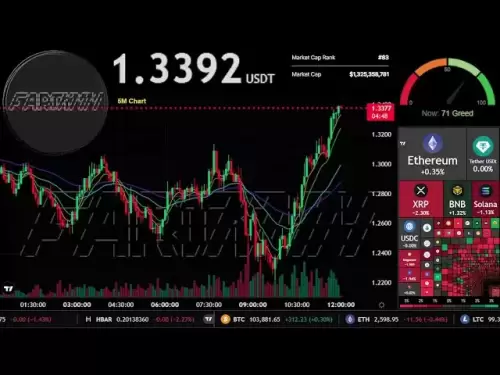 |
|
 |
|
 |
|
 |
|
 |
|
 |
|
 |
|
 |
|
 |
|
 |
|
 |
|
 |
|
 |
|
 |
|
 |
|
Cryptocurrency News Articles
The slow adoption of stablecoins in Canada has some local crypto industry observers concerned that the country is falling behind.
May 16, 2025 at 01:15 am
The Canadian Securities Administrators (CSA) classified stablecoins as “securities and/or derivatives” in December 2022 after the FTX debacle
The slow adoption of stablecoins in Canada has some local crypto industry observers concerned that the country is falling behind.
Canadian Securities Administrators (CSA) classified stablecoins as “securities and/or derivatives” in December 2022 after the FTX debacle that shook markets and turned many lawmakers against the crypto industry.
Regulating stablecoins as a security has seen few local stablecoin issuers arise, but in the United States and the European Union, softening regulations have seen significant growth in the stablecoin market. This makes Canada, observers say, less competitive with other jurisdictions. Of particular concern is the perceived gap in peer-to-peer (P2P) payments in Canada, which stablecoins are uniquely qualified to fill.
Local law constrains stablecoin growth and threatens dollar
In 2022, as the crypto market reeled from the collapse of FTX and the implosion of the Terra stablecoin system, regulators worldwide began to look more critically at the crypto space.
In Canada, the CSA updated regulations for crypto exchanges and brought stablecoins under its purview, classifying them as securities/derivatives. This hasn’t been a popular decision with Canada’s crypto industry.
Morva Rohani, founding managing director of the Canadian Web3 Council, said that the CSA’s case-by-case basis for considering stablecoin issuers and the lack of a federal framework make for a “patchwork” regulatory regime.
“Canada’s reliance on securities law to regulate payment stablecoins introduces significant legal and operational uncertainty,” she said.
Tanim Rasul, chief operating officer of Canadian crypto exchange NDAX, said that the CSA “got it wrong,” stating that other regulatory frameworks, like the EU’s Markets in Crypto-Assets (MiCA) law, were more appropriate.
“I would just say, look at MiCA, look at the way they’re approaching stablecoins. It’s a payment instrument. It should be regulated as such,” he told a crowd at the Blockchain Futurist Conference in Toronto on May 13.
It’s not just the EU. Singapore and the UAE have also introduced regulatory frameworks for stablecoins, and US senators are optimistic they will pass a stablecoin law by May 26.
Rohani said Canada is “out of step with leading global jurisdictions [...] which have adopted tailored, prudential frameworks that recognize stablecoins as payment instruments.”
This lack of alignment with other, more pro-stablecoin jurisdictions could have negative effects for the Canadian dollar (CAD), some worry.
Som Seif, founder of Canadian investment firm Purpose Financial, said that the proliferation of other major stablecoins, mostly denominated in the US dollar, could threaten the use of the loonie (a nickname for the Canadian dollar) at home.
“If Canada does not create the regulatory framework and environment that encourages the development of CAD stablecoins, consumers and businesses will default to using USD-pegged alternatives, eroding the relevance of CAD in global markets,” he said.
Stablecoins provide cheaper P2P payments but reputation is also a roadblock
Members of the Canadian crypto industry have stated that stablecoins have a role to play in the country as well, given the purported lack of P2P payment networks available in the country.
Speaking to Cointelegraph on May 13, Coinbase Canada CEO Lucas Matheson said, “It’s really important that we have a stablecoin for Canadians.” He said that the only options currently open were wire transfers, which “cost $45 and take 45 minutes of paperwork.”
Rohani said that Interac e-Transfer, a Canadian funds transfer service, “remains the primary domestic P2P rail, operating through banks and credit unions.”
Canada does have apps like PayPal and Wise, which support international P2P transfers, but those often come with high commissions and slow settlement times compared to stablecoins.
Rohani said that while some crypto platforms allow for P2P transfers, they’re not widely used due to a lack of integration into mainstream financial services.
Demand for more and different digital payment methods is growing in Canada, according to the 2024 digital payments report from Payments Canada, the owner and operator of Canada’s payment clearing and settlement infrastructure.
But that demand may not translate directly into stablecoins. Crypto’s “journey towards financial integration among Canadians remains a distant prospect,” the report reads. Some 91% of Canadians have never used crypto as a payment.
Payments Canada attributes the lack of interest to the assets being perceived as the “least secure payment method among Canadians compared to alternatives such as cash, credit cards, cheques, wire transfers and PayPal.”
Even in the context of a central bank digital currency, which the crypto industry generally regards as a less favorable option to private, fiat-denominated stablecoins, interest just isn’t there. The survey found that 85% of respondents “did not envision themselves using a digital Canadian dollar and
Disclaimer:info@kdj.com
The information provided is not trading advice. kdj.com does not assume any responsibility for any investments made based on the information provided in this article. Cryptocurrencies are highly volatile and it is highly recommended that you invest with caution after thorough research!
If you believe that the content used on this website infringes your copyright, please contact us immediately (info@kdj.com) and we will delete it promptly.



























































